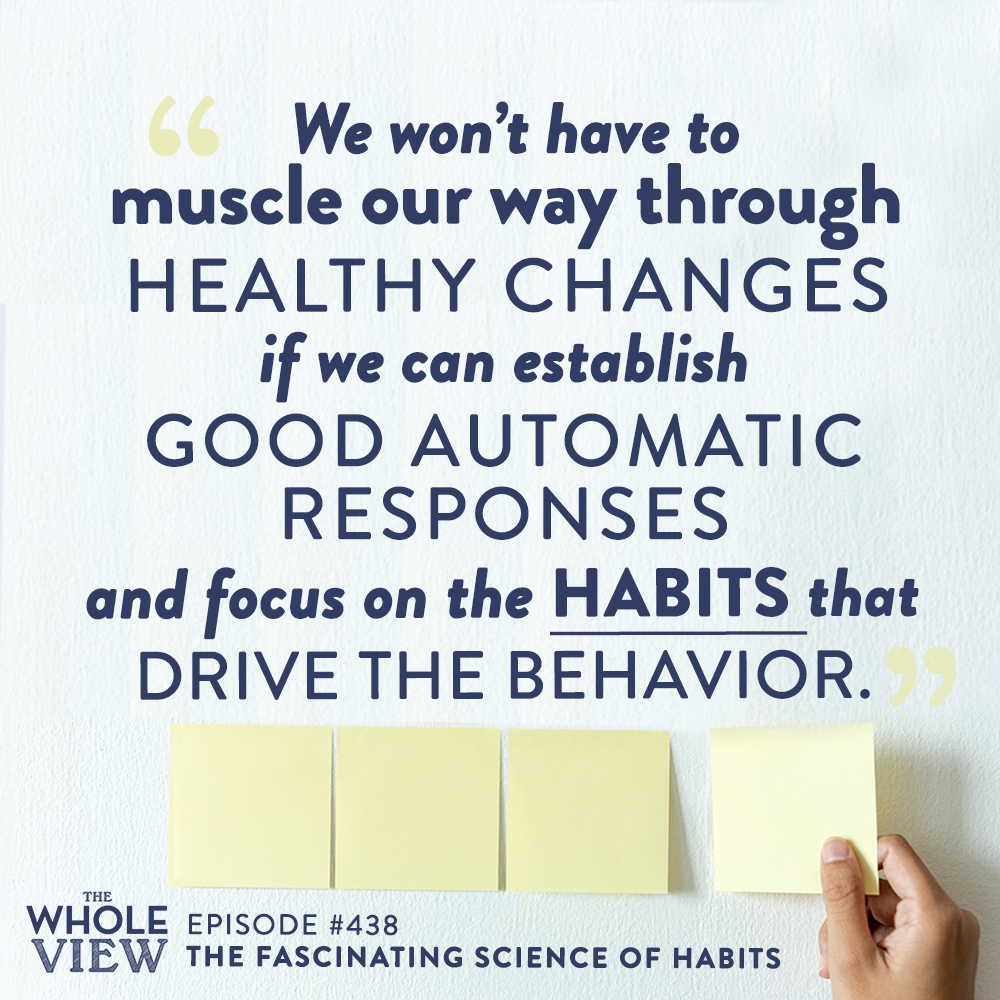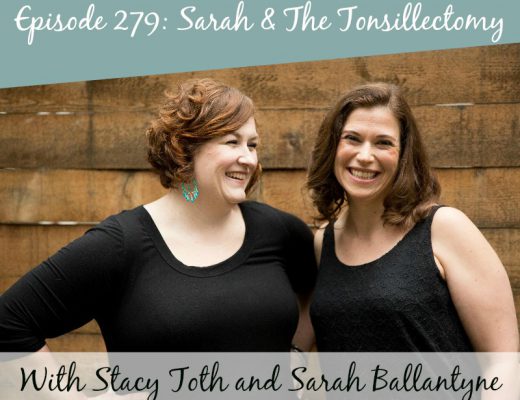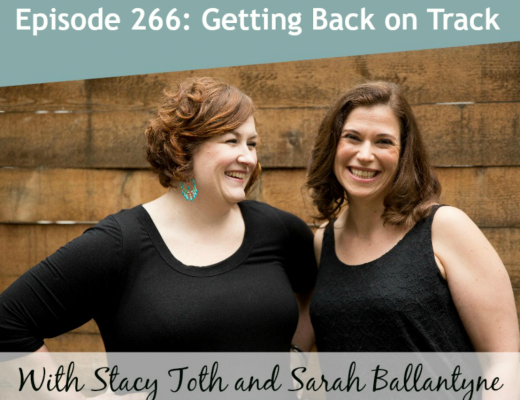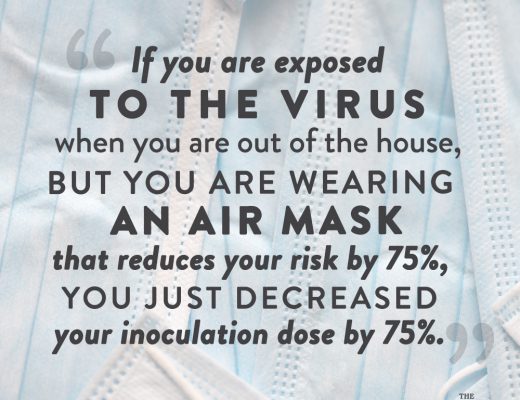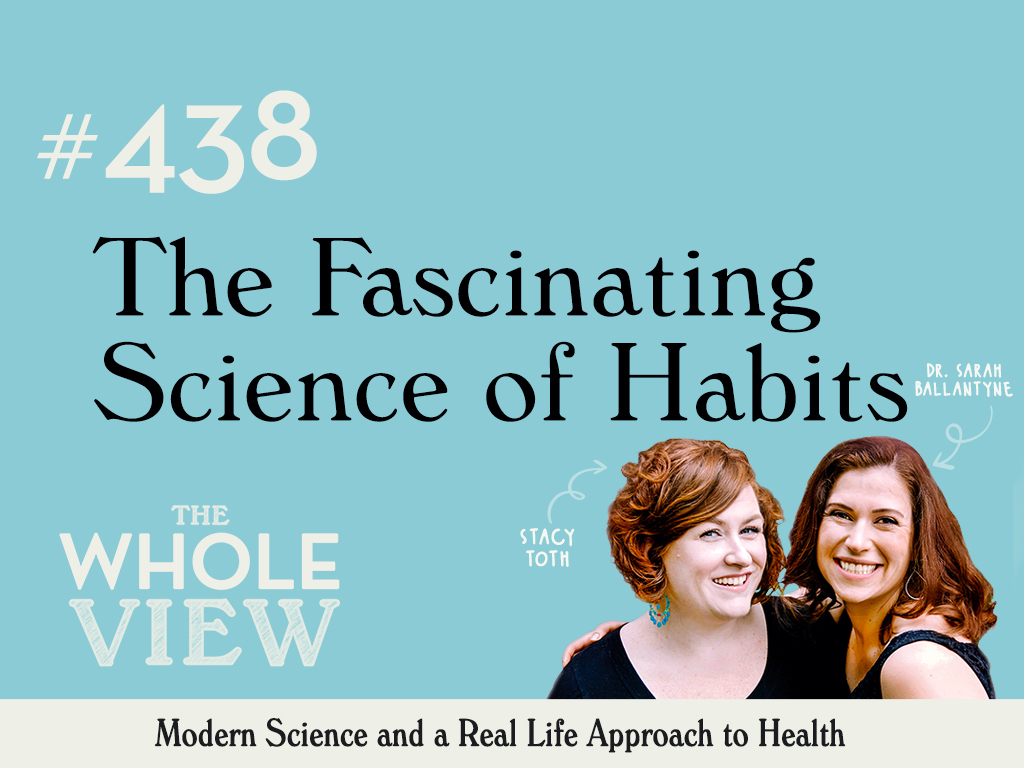
Welcome to episode 438 of The Whole View! This week, Stacy and Sarah look into the science of habits, explore how habits are formed, and ways that we can use it to our advantage. Sarah shares several tips listeners can use to increase their chances of establishing successful routines. She also explores the science of habits that are bad for us and offers strategies for effectively breaking them!
If you enjoy the show, please review it on iTunes!
The Whole View, Episode 438: The Fascinating Science of Habits
Welcome back to episode 438 of the Whole View. (0:27)
Stacy welcomes listeners to the very first show of the year!
She is still readjusting to life after the holidays and knows everyone can identify with that sluggish feeling of getting back to routine.
Sarah is a little different because she makes habit-centered resolutions every year.
She takes the New Year as a time to reevaluate what she’s planning to do in a habit-focused, not goal-focused, frame.
This year, she thought a lot about body shaming and predatory marketing strategies of big business.
She always finds the “new year, new you” mindset nauseating every year. But this year, whether it’s because of the “quarantine 15” or something else, it’s particularly bad.
Especially given how emotionally vulnerable Sarah is feeling after 2020.
This led Sarah to look into what’s new in habit-forming research and refresh her knowledge of the science of habits since she hadn’t done so in several years.
There is so much cool science on habits, and Sarah jokes she fell down the rabbit hole.
When she emerged, she realized how actionable it is. And how it can help pull on a lot of threads on how we can set up to succeed, period.
What Are Habits?
Sarah suggests they start by looking at what scientifically is considered a habit. (4:00)
She thinks that it’s a bit more common to think of habits in the sense of bad ones we want to break, like smoking or nail-biting.
Sarah explains that while we more easily identify “bad habits,” habit-forming as a whole is a very important form of learning.
A habit is a learned action that we perform automatically when we encounter that action’s linked stimulus.
When the action is triggered, we perform it automatically and unconsciously.
Real, fully-formed habits are insensitive to the “reward” phase we initially rely on to form the habit.
Sarah also explains that we perform habitual behaviors in the exact same way every time we encounter the stimulus.
And once we reach the point where it does matter if there is a reward for performing the habit or not, the behaviors tend to stick with us long-term.
This is true even if the perceived benefit we derive from the behavior decreases over time or no longer distinguish a cause and effect of our behavior.
Science of Habits In Daily Life
We perform about 40% of our day-to-day actions are habitual, meaning they are determined by stimulus-response associations and requires no conscious thought. (6:00)
We evolved the ability to form habits because it does something important in terms of freeing up thinking resources.
When we’re learning a habit, it starts as a routine to achieve an outcome (i.e., goal-directed), rewarded as reinforcement, and repeated in the same context.
Sarah explains at the beginning of this learning process, the brain must use multiple areas to perform the behavior.
- Basal ganglia is the region of the brain associated with emotion, memories, pattern recognition, procedural learning, and control of voluntary motor movements.
- The prefrontal cortex is the region of the brain associated with executive function and cognitive control. This includes attentional control, cognitive inhibition, inhibitory control, working memory, cognitive flexibility, information processing, planning, reasoning, problem-solving, organization, and decision making.
As we repeat the behavior and master it, we use the prefrontal cortex less and less to perform the behavior. This is when the basal ganglia takes completely over.
Once the action becomes a habit, we don’t use the prefrontal cortex at all. This frees up valuable executive functions for other tasks!
Sarah used the example of learning to drive a car and “losing time” while driving long distances to show how prevalent the science of habits is in our lives.
The Science of Habits Behind Social Language
The habit learning system increases efficiency, saving valuable mental energy, but comes at the expense of flexibility.
Stacy jokes that while you can listen to a podcast, such as The Whole View, she doesn’t recommend attempting to read the show notes while habitually driving your car.
Sarah agrees that reading is not habitual enough to do while driving because words are heavily reliant on the frontal cortex. The exception to this, she explains, is social language.
For example, we might be so conditioned to hearing “Hi, how are you?” from a stranger, if they say, “wonderful day, isn’t it?” we might automatically answer with something like, “Great! How are you?”
Sarah explains social language is a form of habitual learning due to our use of “programmed responses.”
She references a scenario when someone passes you on the street and asks how you are.
They don’t really want to know all the horrible things that might have happened to you that morning. Because you’re socially aware of it, you have a programmed response along the lines of, “good, how are you?”
Sarah also shares encounters with her grandmother, who has dementia.
She explains that much of their conversations revolve around these scripted, programmed responses.
This is because her grandmother spent a lifetime building those responses. So her deteriorating memory can more easily hold onto them.
Why Focus on Habits?
Sarah notes that we tend to fall back on habits, whether good or bad, when we’re distracted, stressed, anxious, or tired. And we tend to perform automatic behaviors more often. (12:45)
Sarah explains that this is why it’s so important to focus on what kinds of habits we’re forming.
We want the behavior we perform when unconsciously to help us toward our goals, rather than undermine us.
This is both why bad habits can undermine our ability to progress towards a goal. And why good habits can keep us on track (without the need for willpower or self-control) even when life gets overwhelming.
Studies have shown that people who score highly in self-control measures don’t achieve their goals because of that self-control exertion.
Rather, these people are highly effective at forming good habits that contribute to successful outcomes even when on “auto-pilot.”
Sarah explains we can actually use this system to make changes that can stick through stressful times and tiring days.
We won’t need to muscle our way through healthy changes if we can focus on the habit that drives the behavior.
How to Form a Good Habit
Stacy jokes that she thinks of herself as someone in control to a disturbing level. (14:54)
While she was listening to Sarah, she began to think of all the things that creep up on her that she doesn’t always have great willpower about. A lot of those things are also things she doesn’t tend to have focused habits for.
She poses the question to Sarah whether she could have difficulty forming habits in those areas because the behaviors hit her brain differently?
Setting Up The Learning Phase
To answer Stacy’s question, Sarah dives into the protocol from this scientific paper about the formation science of habits. (16:02)
The paper aims to guide physicians in helping to improve their patient’s health by focusing on habit formation.
- Decide on a goal that you would like to achieve for your health.
- Choose a simple action that will get you towards your goal, which you can do on a routine basis.
- Plan when and where you will do your chosen action. Be consistent: choose a time and place that you encounter at least daily.
- Every time you encounter that time and place, do the action.
- It will get easier with time, and eventually, you should find you are doing it automatically without even having to think about it.
The Role Of Time In The Science Of Habits
Sarah informs the audience the commonly accepted “21 days to make or break a habit” is, unfortunately, a myth.
Research actually shows the average length of time to form a new habit is 66 days. However, it can vary from 18 to 254 days. That’s about 8 months!
Sarah explains that when we think about this in terms of developing good habits, we realize we need to get from the 21- or 30-day “challenges” we see everywhere.
It’s just not long enough.
Stacy says that for her, a 30-day challenge has felt like a habit by the end and wonders if Sarah can shed any light or hope on that.
Sarah explains that there are a few things at play here:
- First, habit-learning is inherently easier for some people. Generally, a really strong memory can speed up the time it takes to form a habit.
- The difficulty or complicatedness of the task also plays a role in how quickly we’re able to habitualize it.
- How often we repeat the task throughout the day. If we’re only doing the behavior once a day, it will take longer.
What We Do To Help
There are some things that we can do to support habit formation. And potentially speed up the time investment as well!(21:33)
First, Sarah explains that starting off with a positive attitude can significantly help how quickly we learn the behavior.
Stacy says it makes so much sense that someone being open and excited about change has an easier time making that change.
A study evaluating habit formation’s psychological determinant revealed that starting with a positive attitude about the new behavior predicted a higher level of automaticity after four weeks and habit maintenance at 8 months.
- Participants were motivated to develop a flossing habit with persuasive information about the benefits of flossing and instructed to floss daily.
- A questionnaire measured attitude by asking strongly agree to disagree with statements related to the information strongly.
- The more the person understood the benefits of flossing, the more likely they were to form a strong flossing habit!
Sarah shares that she saw a lot of herself in this study.
She is a person who always sees empowerment in knowledge. And she naturally seeks out the science behind any particular choice she is making.
It’s understanding the whys behind those benefits that drive the choices she makes into becoming habits.
She tells listeners that finding out and understanding the whys behind their choices can help them reach their goals.
The Role Of Reward In The Science Of Habits
Sarah reminds listeners that once a habit is fully formed, a reward no longer matters. (23:50)
However, thinking about how we can up the reward in the beginning stages can help speed up how long it takes us to fully form the behavior.
- A simple neurological loop, called the habit loop, is at the core of every habit.
- The habit loop consists of a stimulus or cue, an action performed in response to the stimulus, and a reward.
- This reward reinforces the loop while the habit is being formed.
Studies show increasing the perceived reward strengthens habits beyond the impact of repetition.
This means it takes fewer repetitions for a rewarded behavior to become a habit than an unrewarded behavior.
Types of Rewards
Pleasure is a positive and immediate sensory outcome that we perceive as a reward.
Sarah explains we get pleasure from delicious foods and intoxicating substances. It’s what makes them so easily habit-forming.
Pleasure is a left-over survival instinct that drives up that reward.
This triggers the brain to seek out and consume high-fat foods as often as we can to bulk up the fat stores needed to survive scarce food times.
What Sarah finds most interesting is how habit formation changes this reward. Once we have a junk food habit, we don’t experience the enjoyment of it in quite the same way.
Intrinsic motivation is wanting to act because of the anticipated inherent enjoyment of doing so.
Sarah explains that this reward is where positivity plays the biggest role.
Sarah explains that intrinsic motivation has shown to be a more powerful reward than extrinsic motivation or action to please others.
For example, people who quit smoking for themselves have far greater chances for success than smokers who quit for their families.
Positive outcome expectancy involves understanding a good effect will result from the action. The other side is a negative outcome expectancy, which hinders habit formation.
Studies have shown that associating a negative experience with a task devalues the reward.
And Sarah explains that understanding how negative expectancy can derail our progress can help us avoid pitfalls.
You can apply these studies’ insights by thinking of ways to up the reward ante when you perform your repetitive task.
Sarah reminds listeners that it’s okay if the reward is delayed. Some studies show it might even be better to be delayed. What matters is that the reward is clearly associated with the behavior.
Sarah and Stacy talk a moment about instances of dog training. And how much more effective positive reinforcement is.
How Science Of Habits Can Help Break Bad Behaviors
Sarah explains that the best way to break a bad habit is to replace it with a good one. (32:41)
This is because breaking a bad habit means that ceasing doing something we learned to do automatically. And it’s harder to break a bad habit than it is to form a new one.
Sarah also tells listeners one thing not to do: exert willpower!
Studies show that using willpower or self-control not to do something causes a rebound effect.
One study found that people who suppressed their thoughts about eating chocolate ended up consuming significantly more chocolate than those who didn’t.
Sarah explains that finding something you like to eat instead of chocolate decreases our urge to obsess over something we want and can’t have.
A similar study found that smokers who tried not to think about smoking ended up thinking about it and craving it even more.
How Can We Break A Bad Habit?
Sarah suggests creating some interference with the behavior. This forces the prefrontal cortex to kick in, stop the automatic behavior, and think about what it’s doing. (37:19)
Sarah cites this study showed forcing people to eat popcorn with their non-dominant hand at the movies helped break the habit of snacking at the theatre.
This same study found that habitual popcorn eaters even ate stale popcorn without thinking about it and supports the idea that reducing reward doesn’t break a bad habit.
Other studies have shown that if you delay the behavior long enough for conscious thought to kick in, the brain can switch to goal-directed behavior.
Sarah tells listeners that this can be as easy as moving the snacks to a different cupboard.
She also adds these strategies aren’t an automatic, over-night solution. But disrupting the behavior gives you time to modify it.
Removing The Stimulus
The best way to break a bad habit is to remove the stimulus. (40:45)
Studies have shown that removing the cue or trigger for a habitual behavior is one of the most effective ways to break a bad habit.
This is why so many people find it easier to quit smoking while on vacation. Or why wellness retreats can be such a great jump-start for a health journey.
Similar studies have shown that changing the environment is important for treating substance abuse.
Sarah suggests applying the insights from this research by thinking through the habit you want to break and identifying the stimuli.
If it’s not possible to remove the stimulus entirely, think about how you can change or disrupt the stimulus enough that your prefrontal cortex has to kick in.
If you can manage to do it, you can switch to goal-directed behavior instead.
Sarah also warns of unintentional removal of a good habit stimulus. A break from school or work for the holidays has shown it can disrupt the habit of going to the gym.
She adds that this is why it’s so easy to derail from our healthy lifestyle over the holidays. And explains why it’s so much work to get back on track in January!
One last strategy Sarah finds worth mentioning is mindfulness:
One study shows mindfulness reduced craving-related eating by over 40%. Another showed increased the success of quitting smoking by 5x over the American Lung Association’s Freedom From Smoking treatment!
New Year, Same Amazing You!
Stacy takes a moment to highlight she and Sarah have been using the word “bad” to reference some parts of the science of habits. (45:00)
She reiterates it doesn’t mean you are a bad person for having formed a habit you now want to modify.
They are using the word “bad” more as an umbrella term for something that does not positively affect your health.
She and Sarah are not here to judge anyone or make anyone feel bad.
Their goal is only to help you make the best choices you possibly can for you and your body,
Stacy doesn’t try to change her habits because it’s a new year.
There is no “new year, new Stacy” because it’s too much too fast and just not sustainable.
Stacy encourages you to be realistic about the changes you’re making, why you’re making them, and to be sure you’re making them for the right reasons.
Keeping these things in mind, we set ourselves up for success.
We can also avoid failure or other negative experiences that can sabotage our progress. Or make it more difficult the next time we try.
Sarah reminds listeners that the key to success is to maintain the routine long enough to reach a habit.
This means setting up a routine that’s sustainable!
Final Thoughts
Stacy shares that she got a lot of great things out of this show. And there are several things she plans to work on going forward. (53:09)
She loves the idea of approaching things from a place of positivity and rewarding herself accordingly- like buying a new plant!
Stacy takes a minute to update listeners on her houseplants.
Sarah shares she is keeping her resolutions simple this year.
Her main resolution is to make a big batch of soup every week, so there’s always have homemade soup around. Not even to drink more of it, just to have it.
She also wants to identify and (hopefully) remove her snacking habit stimuli.
She wants to make sure any snack she has is an intentional choice and not automatic.
Finally, Sarah wants to keep up my good bedtime and morning routines in the hope that they will soon become habits.
Stacy reminds listeners that having an “accountability buddy” to talk with is very important when setting yourself up for success.
Sarah shares that she hopes learning the science of habits helps listeners break behaviors and establishing better ones.
She adds that there is no rule saying we can only make resolutions on January 1st. And thinking about habits on a continuous level can help us be the best we can.
Stacy reminds everyone to check out Patreon for bonus content from this episode.
Thank you so much for listening, and we’ll see you next week!
